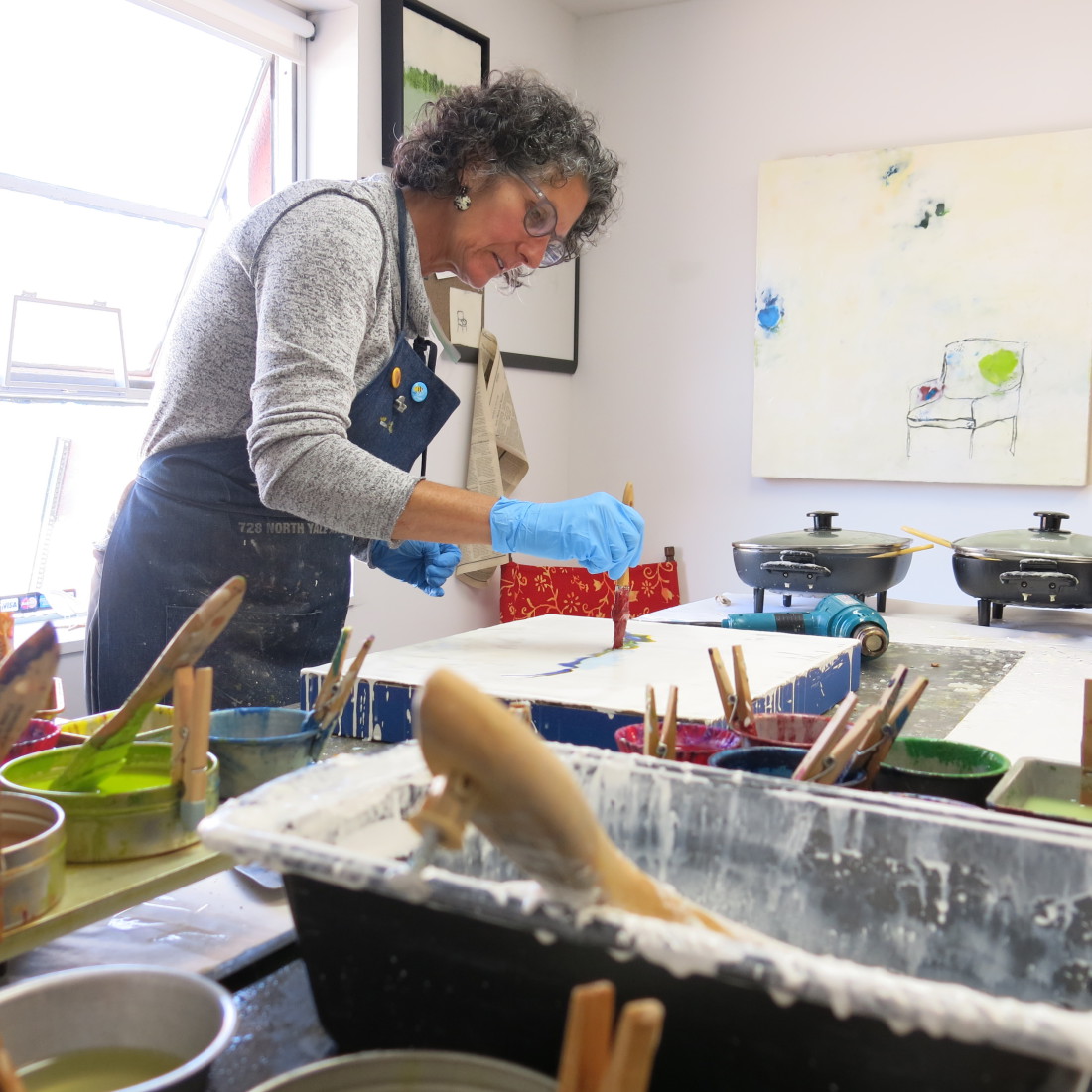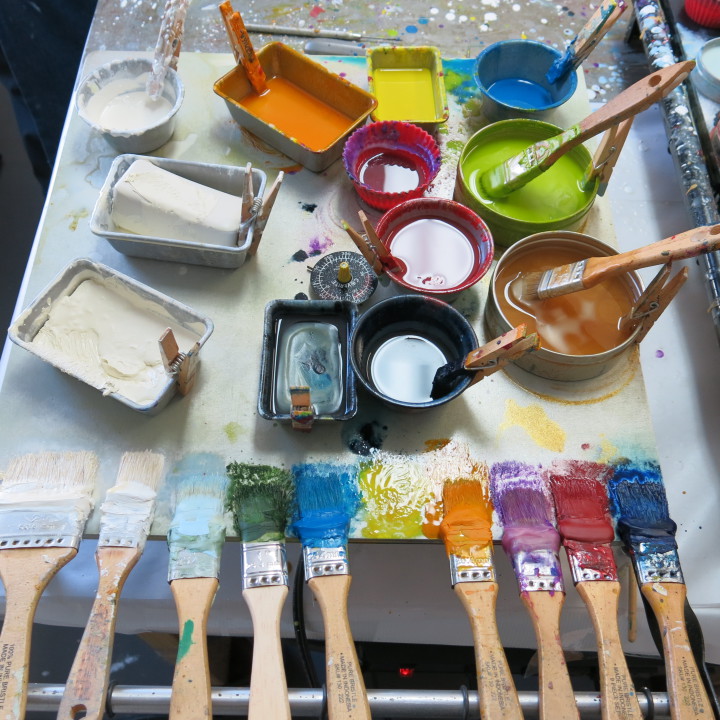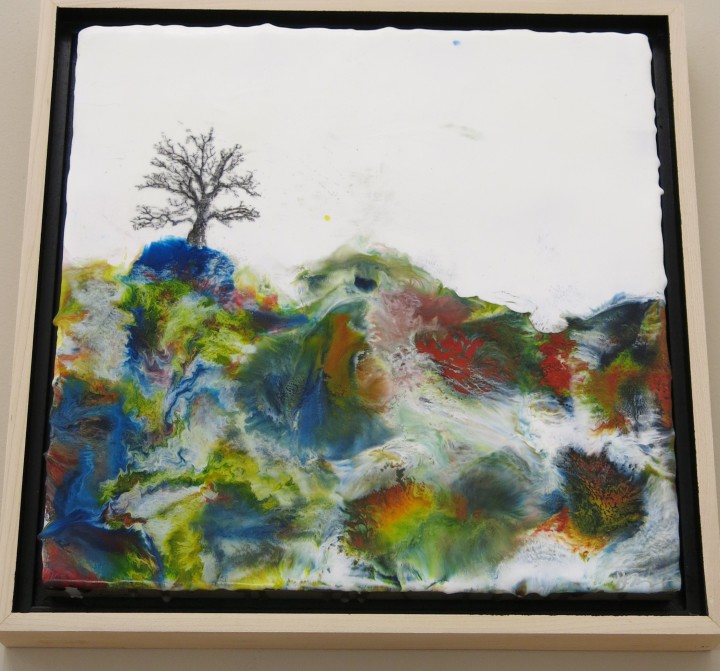Unfamiliar with encaustic painting? You’re not alone. Encaustic painter Julia Fosson, whose workshop is located in the Hatchery Studios in the River Arts Districts, spent years unaware of the art form. It is a multifaceted, multilayered medium that involves beeswax, blow torches, heating guns and hot plates, along with dammar — a type of tree sap in which the beeswax is cooked.
For Fosson, the layering process is what drew her to the style. It allows her to explore the emotional idea behind any given piece throughout its various stages. In some instances, her work takes on recognizable scenes (colorful mountains and flowers), in others she gives way to the abstract. A few of Fosson’s pieces contain hidden messages placed beneath the beeswax itself (embedded stories of inspiration and as articles advocating equal rights — no buyer will ever see them, but Fosson hopes they will be sensed).
Fosson’s story of becoming an encaustic painter has its own layers. For 20 years and across six states, her primary title was not that of artist, but hand therapist. Art played its role. Early on, she made oil paintings but identified the art form more as a hobby, designated to the garage and done during her free time. For a woman working 12-hour shifts, in a practice that required a 24/7 on-call status, opportunities to create didn’t come easily. “I had to always work on making art happen,” Fosson says. “And that didn’t feel good.”
A patient of Fosson’s lead her to a career in art. At the time, Fosson lived and worked in Hartford, Conn. She had cut her hours to part time, in order to focus on her oil paintings. It was during this period that a patient suggested she look into the Farmington Valley Art Center, a nonprofit that supports working artists through studio space and community. Fosson visited the center and was encouraged to bring in a portfolio, the first step required for a juried studio space.
“I’m a confident person,” Fosson says. “I’ve assisted in amputations and finger transplants, but when it came to my art, I had no confidence.”
On the day she was to meet the jury committee, Fosson spent 30 minutes inside her parked car, sitting outside the Farmington Valley Art Center, portfolio in hand. Once she worked up the courage to present her paintings, she was juried in. The small studio space was Fosson’s first non-residential workspace.
It was at the Farmington Valley Art Center that a fellow artist commented on Fosson’s style. Her oil paintings were heavily layered, which reminded the fellow artist of the encaustic method. Fosson had never heard of the form, but its process intrigued her.
That interest led Fosson to upstate New York where she took a workshop on encaustic painting. She fell in love with the form. Layered backgrounds had always spoken to her. New York, however, was a trek — one that led Fosson to write two grants (one to the state of Connecticut, the other to the Arts Council of Connecticut, Hartford). In both cases, she pointed out that residents such as herself had to travel across state lines to learn a craft. Why not keep it in-state?
To her surprise, Fosson was awarded both grants. The money allowed her to purchase equipment and hold classes. It also raised questions: Could she turn her art into a full-time gig? Could she say with confidence that she was an artist? Without formal education, who would believe her? Would she believe herself? What would her contribution be at home? She and her partner, Sharon, were in the fortunate position to no longer need Fosson’s income as a hand therapist, but that didn’t ease her own sense of duty. But, “I was 45 at the time,” Fosson says. “I knew if I didn’t follow my passion then, odds were it never would happen.”
It’s been 10 years since Fosson decided to become full-time encaustic painter. She’s spent the last five years calling Asheville her home. Over this period, her work has evolved. While she still deals heavily in the abstract, her more recent projects incorporate the concrete: Houses, chairs and trees all find their way into any given piece. She finds the inclusion of familiar objects lend to conversations, which at times lead to stories shared with collectors. It’s through these shared memories and tales that Fosson finds insight that goes beyond any individual journey. “You need to allow yourself to use the gifts you’re given and get out of your own way,” she says.
Fosson’s works can be found at her Hatchery Studio, Woolworth Walk and Asheville Bee Charmer. For additional information, visit her website.






Before you comment
The comments section is here to provide a platform for civil dialogue on the issues we face together as a local community. Xpress is committed to offering this platform for all voices, but when the tone of the discussion gets nasty or strays off topic, we believe many people choose not to participate. Xpress editors are determined to moderate comments to ensure a constructive interchange is maintained. All comments judged not to be in keeping with the spirit of civil discourse will be removed and repeat violators will be banned. See here for our terms of service. Thank you for being part of this effort to promote respectful discussion.